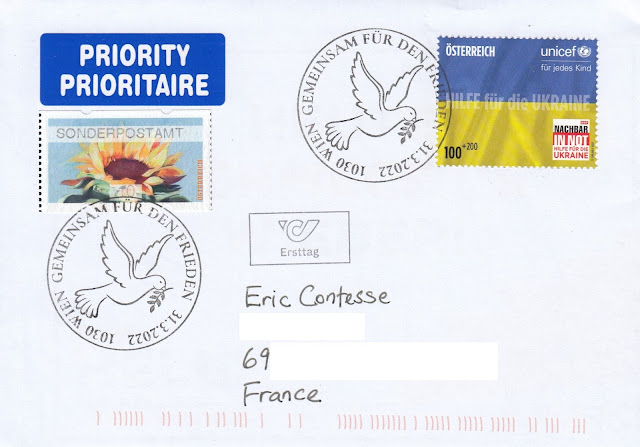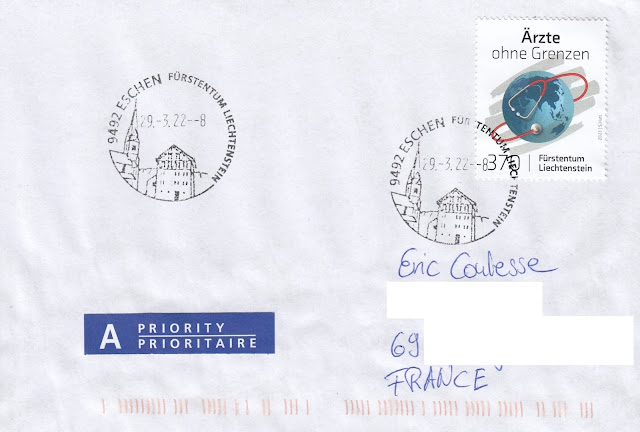Timbre "Ensemble pour la paix - Aidons l'Ukraine" sur FDC d'Autriche
Comme d'autres administrations postales européennes (Lettonie, Estonie, Lituanie, Pologne, Croatie), la poste autrichienne a mis en circulation, le 31 mars 2022, un timbre en soutien à l'Ukraine suite à l'invasion russe déclenchée le 24 février 2022.
Depuis
le début de cette guerre, les pays européens ont manifesté leur soutien
(financier, militaire) envers l'Ukraine et font tout pour isoler le
régime russe, via différentes sanctions économiques.
Malgré ce
soutien, des civils ukrainiens meurent de façon injuste, des villes sont
détruites, des réfugiés affluent dans les pays les plus proches
(Pologne, Roumanie, Moldavie principalement) et cette guerre est
toujours en cours, plus de 2 mois après le début de cette invasion...
Ce timbre autrichien (tirage : 200000), conçu par David Gruber à partir du drapeau ukrainien, figure sur ce pli Premier Jour avec son TAD associé "Ensemble pour la paix" (colombe et rameau d'olivier) de Vienne. Merci beaucoup Edna !
Like other European postal administrations (Latvia, Estonia, Lithuania, Poland, Croatia), the Austrian Post put into circulation, on March 31, 2022, a stamp in support of Ukraine following the Russian invasion launched on February 24, 2022.
Since the start of this war, European
countries have shown their support (financial, military) for Ukraine and
are doing everything to isolate the Russian regime, via various
economic sanctions.
Despite this support, Ukrainian civilians are
dying unjustly, cities are being destroyed, refugees are flocking to the
closest countries (mainly Poland, Romania, Moldova) and this war is
still going on, more than two months after the beginning of this invasion ...
This Austrian stamp (print run: 200,000), designed by David Gruber from the Ukrainian flag, is present on this First Day Cover with its associated "Together for Peace" (dove and olive branch) postmark from Vienna. Thank you very much Edna!
Cette somme de 2€ est reversée respectivement à deux organisations humanitaires expérimentées : l'organisation autrichienne "Nachbar in Not" ("Voisin en détresse"), une association caritative créée en 1992 en collaboration avec l'ORF (la société de radiodiffusion autrichienne), et l'organisation internationale UNICEF venant en particulier en aide aux enfants.
La mention "Aide pour l'Ukraine" figure au centre sur ce timbre, proche de celui émis par la poste croate.
A noter cette vignette de complément "Tournesol" (0,10€, "Sonderpostamt" = bureau postal du service philatélique à Vienne), mise en circulation le 8 janvier 2022. Je ne sais pas trop pourquoi cette vignette a été utilisée car le tarif actuel pour un envoi en France jusqu'à 20g est de 1€...
Gloire à l'Ukraine !
This semi-postal stamp (€1.00) is an act of solidarity from Austria towards the Ukrainian people, with this surcharge of €2.00 intended to provide those affected with what they need.
This amount of €2.00 will go respectively to two experienced humanitarian organizations: the Austrian organization "Nachbar in Not" ("Neighbor in distress"), a charity created in 1992 in collaboration with the ORF (the Austrian broadcasting company), and the international organization UNICEF, particularly helping children.
The mention "Help for Ukraine" appears in the center of this stamp, similar to that issued by the Croatian Post.
To note this "Sunflower" additional ATM stamp (€0.10, "Sonderpostamt" = post office of the philatelic service in Vienna), put into circulation on January 8, 2022. I'm not sure why this ATM stamp was used because the current postal rate for a shipment in France up to 20g is €1.00 ...
Glory to Ukraine!






















